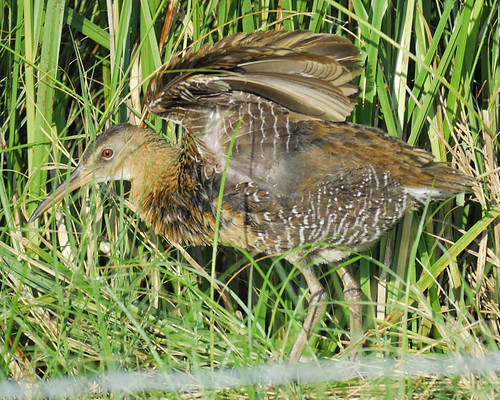tags: King Rail, Marsh Hen, Freshwater Marsh Hen, Rallus elegans, birds, mystery bird, bird ID quiz
[Mystery bird] King Rail, also known as the Marsh Hen or the Freshwater Marsh Hen, Rallus elegans, photographed at Anahuac National Wildlife Refuge, Anahuac, Texas. [I will identify this bird for you in 48 hours]
Image: Joseph Kennedy, 26 May 2010 [larger view].
Nikon D200, Kowa 883 telescope with TSN-PZ camera eyepiece 1/400s f/8.0 at 1000.0mm iso400.
Please name at least one field mark that supports your identification.
Today's Mystery Bird seems a bit confused about its own identity, maybe you can help by identifying its species? (and maybe you know what I am referring to when I write this? If so, please do share!)
This is a King Rail, so-named because it is the largest North American rail species. This species interbreeds with the similar-in-appearance Clapper Rail where their ranges overlap, leading some scientists to think they are actually the same species [another picture of a Clapper Rail].


I'm confused about the confusion. Really. Really. Really. confused.
I clap my hands and I'm still really. really. confused.
I am afraid that I agree with Ashok!
Wow, just wow. Beautiful shot, but for me, a difficult bird.
The beak looks bittern or heronish (one of the smaller herons). Except it's a little more turned down, maybe?
The tail is really short, which would work for a bittern or small heron. The legs are strong looking (which, again, works for bitterns or herons) and not very yellow. But maybe that's lighting?
The eye's really orange. Really orange. That might be a juvenile yellow-crowned night heron or a black-crowned night heron.
The throat isn't striped or maybe we're not seeing the stripes well because of the fluffedness, and the head looks a little small for a heron, though.
The bill is dark above and yellowish below. And in my Sibley's that seems to be an immature black crowned night heron thing. Bitterns have more yellow bills in the pictures, and yellow-crowned more dark bills.
Anyway, I'm guessing black crowned night heron in its first summer, disguising itself as a bittern as best it can.
Bardiac -- nice analysis, but you got off on the wrong foot. You were right at the beginning -- the bill is too curved for a heron. The barring on the flanks is also wrong for any of the (N. Am.) herons.
I'm not sure of the species of this bird, but I have an idea on what could have been meant by it being confused about its identity. It looks like it's doing a visual display of a single-wing flash. The only bird I know that does this is a Buff-breasted Sandpiper, though there may be others. Anyway, since this clearly isn't a sandpiper, that could be what it refers to.
I'm nobody's excuse for a botanist, but that looks like a freshwater marsh, with a saltwater marsh bird in it. I think Mr Kennedy deserves a round of applause for this lovely shot.
psweet, thanks for the kind words. It's a good thing I have a day job (and am actually reasonably good at that).
Is it possible that this bird is confused because it's a hybrid?
Ashok: clapping is useful.
Alex: this bird is actually stretching both its wings, so no single wing flash there.
Pete: indeed! Joseph Kennedy has been, for years, extremely generous with sharing his beautiful images as daily mystery birds, and he has provided some incredible images to amaze and delight us. I keep hoping that a magazine will see his images and decide to purchase a few of them, you know, just so he can buy more camera stuff so he can share more bird pictures with us! ;)
bardiac; you are so close, sooooo close to finally unraveling the bird's true identity and to finally answering the question i asked.
to everyone: you are such wonderful sleuths! i love reading your detective work, about the birds' IDs and also regarding the questions i ask. as always, this is splendid fun.
Since bardiac guessed hybrid, and you say that is close ... a Clapper Rail/King Rail hybrid maybe? The former being a salt marsh bird, the latter freshwater marsh - but WhatBird says that they have been known to interbreed where their ranges overlap.
PattyP: i probably should not say anything at all, since my comment seems to have gotten you on the wrong track. i'll just stay silent and let you all work it out.
:(
Oh, I didn't mention the markings that led me to these Rails - the size, slightly downturned bill, marsh environment are common to both (I don't know how Pete can tell it's a freshwater marsh - that's good!)
The more reddish-brown coloration would be King Rail-like, but the greyer head more Clapper Rail-like.
So I'm "getting colder"? Well, looking at the Patuxent Bird ID Center website, it does say that the Gulf Coast Clapper Rail (Rallus longirostris scottii) does have a "cinnamon breast" plus the flanks barred white with dark brown - so my final guess will be a Clapper Rail.
You should take anything I say about plants with substantially more than a grain of salt, Patty. But the bigger plants look to me like cattails, which occur in fresh water in my area. I'm not at all familiar with Gulf Coast saltmarshes, just some areas on the West Coast of the US and the NE part of the Sea of Cortez.
OTOH, if this guy's what I think it is, then it routinely occurs in freshwater marshes here in Arizona, so it wouldn't be confused in the way I thought it was.